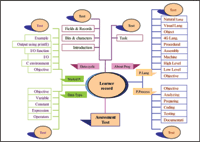People learn in different ways.Learning is a complex, interrelated system of accessing information, getting it into the brain, and processing that information to solve problems or support activities. Understanding learning styles leads to success. Once an individual knows what learning environment works best for him/her and what his/her preferred learning style is, the individual will see how he/she can use the preferred learning style to move information through the learning process and to learn new information more quickly and efficiently, remember new information for a longer period of time, and increase ability to recall the information more quickly and completely for performance, discussion, or test taking.
Mind maps and scorm for course content development
This article presents the mind map approach as one of the learning styles. Mind map is a way of representing information graphically using keywords, links, and key images, allowing a lot more information to be put on a page. Mind map works the way the brain works, which is non linear.
Any idea probably has thousands of links in your mind. Because mind maps are more visual and depict associations between key words, they are much easier to recall than linear notes. Starting from the center of the page rather than top-left corner allows you to work out in all directions. Mind maps are easy to review. Visual quality of mind maps allows you to make key points to stand out easily. Mind map has been used in many fields such as notes, problem solving, planning, and presentations.
Although mind map learning approach is widely accepted, there is still little research on e-learning and teaching using this approach for developing course content. SCORM has become a widely used requirement for e-learning projects. However, there is still a lot of confusion, especially within the instructional design community, regarding what it is and when it should be used. This article presents an experiment in developing course content taking the advantages of one of the most powerful approaches in displaying information visually, in a learning and teaching environment using SCORM standards. The aim of this experiment is to accommodate individual learning styles in an adaptive learning environment that teaches the “C programming language”.
 SCORM standard is another aspect this project is using. SCORM nowadays become a widely used requirement for e-learning projects. There is still a lot of confusion, especially within the instructional design community, regarding what it is and when it should be used. SCORM or the Sharable Content Object Reference Model provides a common technical framework for the development of reusable instructional objects for computer and Web-based learning. This paper presents the design and implementation of course content development based on mind map approach using SCORM.
SCORM standard is another aspect this project is using. SCORM nowadays become a widely used requirement for e-learning projects. There is still a lot of confusion, especially within the instructional design community, regarding what it is and when it should be used. SCORM or the Sharable Content Object Reference Model provides a common technical framework for the development of reusable instructional objects for computer and Web-based learning. This paper presents the design and implementation of course content development based on mind map approach using SCORM.
SCORM is a model that describes a standardized way to design and develop learning materials. The greatest advantage of implementing SCORM standard is that it makes it possible to integrate learning objects from different sources in a common environment. SCORM as model describes two main elements a Content Aggregation Model (CAM), which describes the ways in which SCORM materials are organised and packaged so that they can be exchanged between different learning management systems (LMS) and a Run Time Environment (RTE), which provides the means for the learning materials to communicate with the LMS and for the collection of data to track and monitor learners.
CAM in Mind map implementation
The most important thing is how to package together a collection of learning objects, their metadata, and information about how the content is to be delivered to the user.
Developing SCORM Content Package
For developing any content package the following steps should be followed.
1- Define the course root aggregation.
2- Develop a content package which, contain two main principals component must be developed carefully, first all the physical files such as Assets (Assets are any digital objects of media, text, images, sound, web pages or other data can be delivered to a web client), and SCO (SCO is a collection of one or more assets). Second a manifest file, which is a list of all the resources (SCOs and assets), the organisation, sequencing rules, and all of the metadata.
3- Identify the metadata for each SCO and the metadata for the entire content package by indicating the ownership, cost (if any), the technical requirements, and educational purposes.
4- Zip the content package together with the IMS files, which is standard communication specifying data model between LMS and SCO.
5- Test the package in any LMS to ensure it functions the way you had intended.
Mind Map Course Design
The “C programming language” course was developed based on mind map approach as follows:
1 The root aggregation is defined and all the physical files and their links are developed.
2 The course main page is designed based on Mind map approach using only key words and whenever possible images emphasized by color.
3 Starting from the center of the page and moving outwards, making the center a clear and strong visual image.
4 Create the sub-center.
5 Put keywords on lines using lower case and using color and arrows to show links between elements.
The testing tool used in this stage is TestSuite 1.3.3 ST from ADL.
RTE in Mind map implementation
 Run time environment describes the LMS responsibility to launch SCOs based requests from the learner and the sequencing rules of the content organization. Therefore, the main requirements in this phase are: to have Application Programme Interface (API), which is a set of functions to achieve the communication between the course content and LMS and facilities to utilise details from manifest file through data model. This data model enables the LMS to track learners’ progress. The steps developed in this phase are as follows:
Run time environment describes the LMS responsibility to launch SCOs based requests from the learner and the sequencing rules of the content organization. Therefore, the main requirements in this phase are: to have Application Programme Interface (API), which is a set of functions to achieve the communication between the course content and LMS and facilities to utilise details from manifest file through data model. This data model enables the LMS to track learners’ progress. The steps developed in this phase are as follows:
1. All the physical files in this course have been designed and developed using hyperlink, text, and images such as in. All the course content files have been developed as assets. The nature of the mind map approach requires allowing the learner to jump through the links in the main page. As such, SCOs cannot be implemented due to the following reasons: (1) A SCO is not allowed to contain hyperlinks to other SCOs. (2) A SCO is not allowed to interact with the runtime environment, except through the SCORM API. (3) A SCO is not allowed to create additional windows, unless it can close them reliably when the SCO terminates. (4) A SCO should not contain hyperlinks to resources that May not be available when the SCO is run in different context than the original context [3].
2.The strategy of the course is jumping from section to section through the main page by the links.
3. The manifest file represents the course sequencing and navigation showing the structure of the course organization and all content resources using IMS Simple Sequencing, which is the specification, which describes three models: sequencing definition model, tracking model, and activity state model. Manifest file also represents the navigation model which indicates how the content is presented to the learner by controlling certain user interface devices that the content May wish to provide, such as Continue and Previous.
Because of the nature of the mind map, only the following aspects in SCORM sequencing definition model and navigation presentation has been implemented:
Sequencing control choice: This indicates that the learner is free to choose any activity in a cluster in any order without restriction, which contains a boolean (True/ False). Therefore False was chosen to prevent the learner from browsing the course through the cluster instead of the map, which is the heart of the mind map approach. • Sequencing control choice exit: This indicates whether a Choice navigation request can target activities that are not descendents of the affected ctivity, thereby causing the affected activity to terminate. This element contains a Boolean (True/False). The value True indicates that while an activity is active the learner has the ability to trigger Choice navigation requests that targets nondescendent activities. • The Continue and Previous devices have been disabled to enforce the learner to navigate the content object through the map only. The tracking and activity state model is simply recording progress and have no interest in user preferences or learning styles. Therefore, implementing advanced function such as prerequisite or other pedagogy Hanan Dageez from Libya is a lecturer in Libyan High Institute and university and the head of computer science department in High Institute. She has a Masters in computer sciences in 1999 from University of Malaya, Malaysia. Currently Hanan is doing her Ph.D research in Education management at University Tun Abdul Razak, Malaysia. concepts are not easy to handle and in some cases, impossible to implement. The course content implementation This work is part of research work done and Sample RTE 1.3.3 from ADL has been modified and used as LMS to cope with this research. First the course must be uploaded and the prerequisite chapters identified by the administrator from the main menu to choose how many chapters this course contains and then the prerequisite chapters for each chapter will be determined for the course. When a learner logs in into the system and registers for the course the system allows him to view the content by displaying the mind map main page. Through the links the learner reviews the course and by answering the tests and the assessment test tracks progress by recording the chapters he/she have failed to answer their questions correctly. The learner, in this case, has to redo failed chapters with all the prerequisite chapters. Even though the learner quits accidentally and gets back into the module, by clicking on “Learner record”, the list of remaining chapters will appear to remind the learner to finish them for record in completing the course.





















